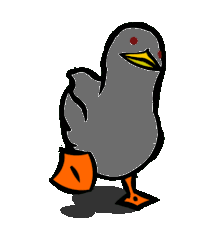Gooselection
Here you can find kind of sandbox natural selection simulation named Gooselection. Express yourself and have fun using variety of instruments to set geese in different situations. See with your own eyes, how the nature adapts to rapidly changing conditions and how do creatures evolve to survive.
Rules
So, the rules of this simulation are pretty simple. There are some
 at the field, they eat
at the field, they eat
 . Also, there are some
. Also, there are some
 , they eat
, they eat
 .
.
Both of them have such parameters as speed, sense and energy. Speed defines how fast geese moving, sense -
the distance from which they can feel food. Of course, they would evolve endlessly if being fast and sensitive would not require
energy, and that is why we need it. When energy of  is at zero, it
becomes
is at zero, it
becomes  . That's not the only way to die, geese are also dying
when negeese murder them and both of them dying when you shoot them (use LMB), anyway this is a simulation of
natural selection, not a shooter, so don't use the riffle too often.
. That's not the only way to die, geese are also dying
when negeese murder them and both of them dying when you shoot them (use LMB), anyway this is a simulation of
natural selection, not a shooter, so don't use the riffle too often.
Despite the huge variety of opportunities to die, geese can also survive and even breed. If the goose eats up 2 pieces of food,
it becomes  , which means that it can't be eaten
(because of huge layer of "armor", yet can be shooted though), can't move (still because of huge layer of "armor") and will
survive this year and produce progeny. Also, if the goose ate one piece of food, but then lost all energy, he will wake up from
a coma next year, but will not produce progeny. Newborn geese, by default, have identical to their parent's parameters, but can
mutate and became a bit more/less sensitive and fast. Also
, which means that it can't be eaten
(because of huge layer of "armor", yet can be shooted though), can't move (still because of huge layer of "armor") and will
survive this year and produce progeny. Also, if the goose ate one piece of food, but then lost all energy, he will wake up from
a coma next year, but will not produce progeny. Newborn geese, by default, have identical to their parent's parameters, but can
mutate and became a bit more/less sensitive and fast. Also  can
mutate to
can
mutate to  and vice versa.
and vice versa.
How to
Using Starting number of geese, Starting number of negeese and Starting amount of apples sliders you can set population and amount of food at the beginning of the simulation.
Food change per cycle and Simulation speed parameters can be also changed during the process of simulation, changes to this two take effect with the start of the next cycle. First one allows to increase or decrease the amount of food on the field in the next cycle. Second one sets the speed of simulation. High speed is not recommended for the big population of ducks because it can lead to freezes and weird lags.
With the start of simulation, you will be able to control the process with 3 new buttons: Pause, Finish and Restart. Pause allows you to "freeze" the simulation at the current moment. The difference between other two is that first one finishes the simulation with the end of the current cycle (that will also happen with the death of entire population) and show you the statistics and the other one just restarts the simulation immediately without giving you access to any simulation stats.
FAQ
Q: A there any system requirements for this application?
A: No, but it may look and work awful in IE and Edge. For better UX use it with wide screen. Neither the less, field size depends on screen size, so to experience new situations, you can try to launch it on mobile phone or tablet
Q: Why geese don't try to run away from negeese?
A: When you see a black goose folowing you, do you expect him to murder you? Neither do they.
Q: Why predaceous geese are called "negeese"?
A: It's an abbreviation for "Negative geese", what did you expect?
